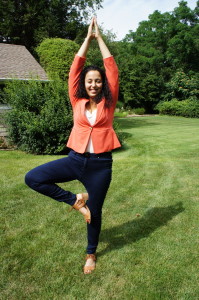
I have always been a student of life. For me, being in the classroom feels natural, so becoming a teacher was a logical career choice. As a young person, I struggled with anxiety and found that expressing myself my authentic self was daunting and, at times, impossible. I was my own worst critic, often plagued by a crippling fear that hindered me from achieving my full potential. In college that fear became palpable, a demon that made my foray into the adult world frightening. Fortunately, this discomfort precipitated a healing journey for me, during which I sought out tools to help myself. Among the most powerful tools was mindfulness. In small ways, I began practicing being present. This entailed mundane, day-to-day activities such as washing dishes, drinking coffee, and brushing my teeth. I would do these activities and simply focus on the task at hand. Initially, I was overwhelmed by my thoughts, as many of us are when carrying out “means-to-end” tasks. But, with practice, I noticed that the thoughts came and went as long as I stayed focused on what I was doing. I put a sign on my bathroom mirror: “Don’t believe everything you think.”
With time and persistence, mindfulness became an everyday practice and informed my study habits and how I comported myself when working odd jobs to support myself. I began noticing how obsessed I was with the future, which created and anxiety gap between the present and future. I found myself hastily rushing from one thing to the next, which allowed anxiety permeate my relationships, my work, and my passion for life. Tormented by this fretfulness, I started taking yoga and meditation classes, learning about mindfulness-based stress reduction and seeking a rigorous physical exercise regimen. I found that all of these tools helped relieved my inner unease. Slowly, I compiled a handful of resources to alleviate my panic. I learned breathing techniques to slow down my heart rate and balancing postures to help relax my nervous system. Gradually, I learned that my anxiety suggested that I needed to slow down, pay attention, and enjoy the process, as they say, as opposed to dwelling on the “destination,” or the result of the process.
When I first learned about mindfulness practices I was apprehensive, because I thought I would be dabbling in spirituality. Since, I have learned that being present in whatever you are doing isn’t solely a spiritual practice, but a necessary life practice. I saw changes within myself, and ultimately, within my family and community. Most noticeably, my classroom environment had shifted from having a sense of urgency to teach a particular topic to having a sense of openness and acceptance to what my students needed most from that lesson. Gradually, my students sensed this shift of haste to calm. I became more aware of the inherent anxiety my students had — whether it was preparing for college, learning how to communicate with a loved one, being a social worker for an underrepresented community, or interpreting to provide equal access for deaf and hard of hearing individuals. Anxiety seemed to be a pervasive part of the human experience, and I was compelled to do something about it.
A to Z mindful education is birthed from my struggles with anxiety—and ultimately, my triumph. My vast experiences have inspired a vision to help students and teachers of all backgrounds learn practical tools to use in the classroom and everyday life. Through the sharing of powerful tools, I envision a classroom revolution. Being a teacher of ASL has granted me access to a beautiful linguistic community rich in history and culture. Working with students who want to learn ASL, I employ mindfulness and find that their skills, motivation, grades and feelings of self-worth significantly improve.
Fortunately, anxiety is no longer a significant part of my life. It ebbs and flows, as all emotions do, but in practicing of many of the simple tools found on this website, I have discovered an unshakeable peace. Certainly, an educational environment can sometimes stir uncertainty about grades, outcomes, and the future, so I feel incredibly grateful to share my experiences with others. Anxiety has been my biggest teacher, and my hope is to share the power of mindfulness with others. Our society often pathologizes anxiety as something we need to eradicate because of the discomfort it brings. A to Z mindful education perceives anxiety as something we need to understand in order to successfully overcome. Through a myriad of tools and collaboration, we can learn how to help ourselves, which then allows us to sincerely help others.